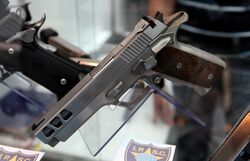Engineering:Bore-axis
The bore axis of a firearm is the longitudinal axis which goes through the center of the gun barrel. In a rifled barrel the projectile will spin around the bore axis as it goes through the barrel.
Bore-to-sight distance
right|thumb|Browning BAR is an example of a weapon system where the sights sit low and close to the bore.
The distance between the bore axis and the sight axis, also known as the sight height, is an important factor to consider due to parallax principles. It is normally desirable to keep the sights of a firearm as close to the bore as possible, since a firearm with a large bore-to-sight distance will require more sight adjustment when shifting between shooting at different targets at close ranges. On the other hand, a firearm with a short bore-to-sight distance will need less sight adjustment when changing between targets at close ranges. At longer ranges the bore to sight distance will be of less importance, since gravity has affected the projectile so much that the height difference between the bore axis and the sight axis has far less impact compared to the bullet drop.
Recoil control

right|thumb|Sig Sauer P226 is an example of a pistol with a high bore axis.
The recoil from a fired cartridge (and the action movement) exerts a rearward impulse along the bore axis, which is commonly above the center of mass of the gun. Meanwhile, the grip areas of the gun, where the user will exert a reactive push against the recoil, is almost always below the gun's center of mass. This couple creates a rotational torque around the mass center and make the gun pitch upwards after each shot — a phenomenon known as muzzle rise. This is more prominent in shorter-barreled weapons such as handguns due to less weight available in front of the mass center to counter the upward rise of the muzzle, and how high the bore axis sits in relationship to the grip hand will also affect the degree of muzzle rise. A low-bore axis will make most of the recoil go directly into the hand, and thus give less muzzle rise. Among other things that affect muzzle rise and felt recoil is the weight of the pistol frame and tuning of recoil springs. The presence of buttstock in long guns will also help negate the effect of muzzle rise by shifting the pivot of the rise all the way to the butt end, thus utilizing the entire gun's weight with a longer lever to counter it.
See also
External links


